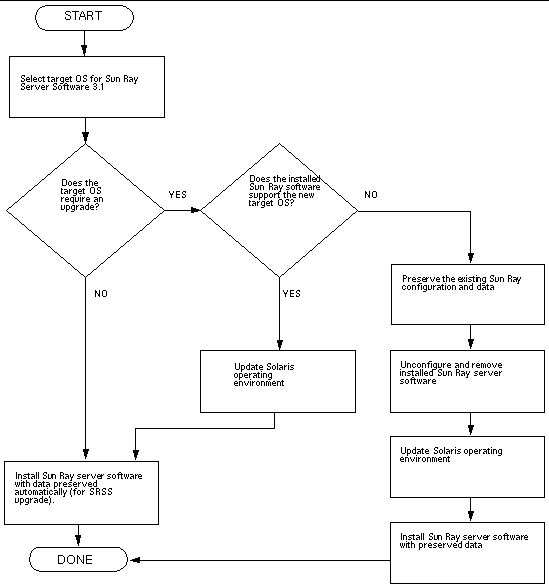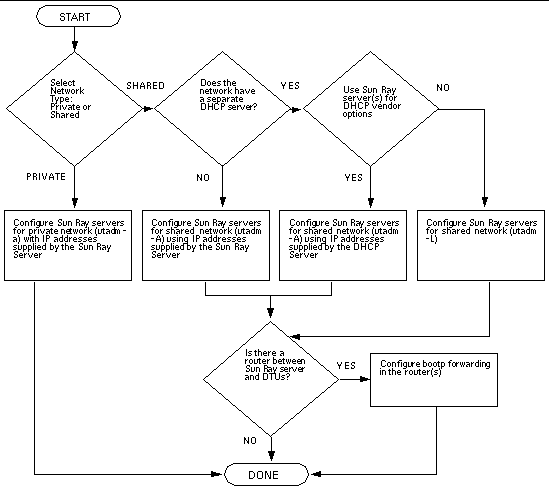| Sun Ray Server Software 3.1 Installation and Configuration Guide
|
   
|
This guide describes how to install, upgrade, configure, and remove Sun Ray Server Software 3.1. It also provides instructions for upgrading to the appropriate version of the Solaris operating environment.
Server Software 3.1. It also provides instructions for upgrading to the appropriate version of the Solaris operating environment.
The reader is presumed to be familiar with basic UNIX® commands and to have experience in network configuration and administration. Technical information and procedures are presented with a command-line interface.
For a visual overview of the tasks to be performed, please look at the decision flow chart (FIGURE 1-1) on the next page. Following the procedures in this guide can help you to avoid unnecessary problems when you install, upgrade, or configure Sun Ray systems.
Media Formats
Sun Ray Server Software 3.1 is available on CD-ROM and ESD (electronic software download). If you download the software electronically, then when instructions and procedures in this guide ask you to change to the image directory on the CD-ROM, please change instead to the image directory under the download directory. Commands issued in either file system should execute properly.
Installation Flow Chart
The following diagram shows the key decisions you should take before performing an installation or upgrade.
FIGURE 1-1 Installation and Upgrade Flow Chart
 [ D ]
[ D ]
This flowchart depicts key decisions that must be taken before installing or upgrading.First, select a target Solaris OS release for Sun Ray 3. If the target OS requires no upgrade, then install the SRSS 3 server software with data preserved automatically, and you're done. If the target OS does require an upgrade, determine whether the installed SRSS supports the new target OS. If so, update the Solaris operating environment, then install the SRSS 3 server software as above. If not, then preserve the existing Sun Ray configuration and data, unconfigure and remove installed Sun Ray server software, then update the Solaris operating environment and, finally, install SRSS 3 with preserved data.
The following table shows which versions of Sun Ray Server Software are compatible with which versions of the Solaris operating environment.
TABLE 1-1 Sun Ray Server Software vs. Operating System Versions
|
Sun Ray
|
Solaris 2.6
|
Solaris 7
|
Solaris 8
|
Solaris 9
|
Solaris 10
|
TSOL
|
|
1.0
|
Yes
|
Yes
|
-
|
-
|
|
|
|
1.1
|
Yes
|
Yes
|
-
|
-
|
|
|
|
1.2
|
Yes
|
Yes
|
Yes
|
-
|
|
|
|
1.3
|
Yes
|
Yes
|
Yes
|
-
|
|
|
|
2.0
|
-
|
-
|
Solaris 8 Update 7 or higher
(Solaris 8 2/02)
|
Solaris 9 Update 1 or higher
(Solaris 9 9/02)
|
|
Trusted Solaris 8
(12/02)
|
|
3
|
-
|
-
|
Solaris 8 Update 7 or higher
(Solaris 8 2/02)
|
Solaris 9 Update 5 or higher
(Solaris 9 12/03)
|
|
Trusted Solaris 8
(7/03)
|
|
3.1
|
|
|
Solaris 8 Update 7 or higher
(Solaris 8 2/02)
|
Solaris 9 Update 7 or higher
(Solaris 9 9/04)
|
SPARC and x86 (Solaris 10 3/05)
|
Trusted Solaris 8 (2/04)
|
|
Note - SRSS versions 1.0, 1.1, 1.2 and 1.3 are no longer supported.
|
This table shows that SRSS 2.0 requires Solaris 8 Update 7 or higher or Solaris 9 Update 1 or higher, while SRSS 3 can run on the same S8U7 or Solaris 9 Update 5 or higher. SRSS 3.1 on SPARC platforms runs on Solaris 8, 9, and 10; however, on x86 platforms, SRSS 3.1 runs only on Solaris 10. Linux implementations require Red Hat Advanced Server 3.0.
Configuration Flow Chart
The following diagram shows the key decisions to take before configuring Sun Ray servers and DTUs on a network, or before configuring a network for Sun Rays.
FIGURE 1-2 Sun Ray Configuration for Various Types of Networks
 [ D ]
[ D ]
| Sun Ray Server Software 3.1 Installation and Configuration Guide
|
819-2383-10
|
   
|
Copyright © 2004, Sun Microsystems, Inc. All Rights Reserved.
 Server Software 3.1. It also provides instructions for upgrading to the appropriate version of the Solaris operating environment.
Server Software 3.1. It also provides instructions for upgrading to the appropriate version of the Solaris operating environment.